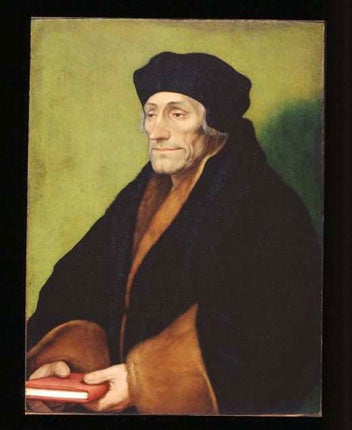Bought for just €2,000 – a Holbein masterpiece that is worth millions

When the dusty heirlooms and bric-a-brac of a once-stately French family went under the hammer at a minor auction eight years ago, an anonymous portrait of the Dutch scholar Erasmus sold for €2000 (£1,900).
The dirty and badly preserved painting was attributed to one of the countless imitators of the great German court painter, Hans Holbein the Younger, and it attracted minimal bidding.
But now it has emerged that the private collector from Zurich who bought the painting got himself a bit of a bargain. Because experts have established that the work was the last ever portrait that Holbein painted of an ageing Erasmus, and the painting – one of a tiny minority of Holbein works to be in private hands – is worth millions.
The discovery, which is reported in The Art Newspaper, has excited Holbein scholars. Because the painting not only marks Erasmus's twilight years (it is believed to have been painted just six years before his death) but also confirms that the two men's friendship continued until the end of the Dutch theologian's life.
The newly discovered work of art has been unveiled in the Boijmans Van Beuningen Museum in Rotterdam, where it is on show as a genuine Holbein in an exhibition on Images of Erasmus.
It was sold on 27 September 2000 by the auctioneer Raymond de Nicolay as an uncatalogued work in a sale of other modestly priced items. After being cleaned by its new owner, who removed the dark background which had been added centuries after Holbein had completed the work, questions over its provenance began to emerge.
Marco Grassi, a New York conservator who was present at the auction in 2000, discovered the fine quality of the work after the crude background had been removed, and was startled by the Holbeinesque way in which the hands, book and fur had been painted. Infra-red photography further showed an under-drawing for the hands which resembled Holbein's methods.
Mr Grassi said: "It was on my advice that he [the Swiss collector] bought it. I thought there was a certain element of chance."
Research on the painting's provenance yielded yet more connections to Holbein. The seller at the auction was a beneficiary of Princess Marie de Robech-Levis Mirepoix, who died in 1997 at the Château de Malesherbes, near Orléans.
She was the last descendant of the distinguished Lamoignon family, who were comprised mainly of parliamentarians and judges, one of whom defended Louis XVI before he was beheaded. The family sprang from the noble Dinteville House, a member of which, Jean de Dinteville, featured in Holbein's most famous masterpiece, The Ambassadors, which currently hangs in the National Gallery in London.
Investigations showed that in 1721 a member of the Lamoignon family became the heir to the Dinteville estate. The last descendants of the Lamoignons died in 1997 and the provenance of the painting beyond the 19th century was unknown, said Mr Grassi. He added that the work might be part of a diptych because Erasmus is shown proferring a book to someone. "It could be a significant gesture, as if he is presenting it," said Mr Grassi.
Holbein completed earlier portraits of Erasmus. In 1523, he painted his first likenesses of the Renaissance scholar who had moved to Basle in 1521 for the city's tolerant cultural atmosphere.
Erasmus was an admirer of Holbein's work, and in 1526 recommended him to his friend, the statesman and scholar Thomas More, when Holbein decided to seek employment in England. In the words of Erasmus: "The arts are freezing in this part of the world, and he [Holbein] is on the way to England to pick up some angels." Dr Peter van der Coelen, a curator at Boijmans Van Beuningen, said the portrait dates from around 1530, during which time Holbein and Erasmus were both living in Basle. The painting has yet to be formally authenticated.
It is extremely rare for Holbein works to emerge on the market, and there have been no major examples in recent decades. Only a portrait of Sir Thomas Wyatt by the artist has recently been on the market with the Weiss Gallery in London for a reported $10m (£6.8m), although there have been questions about its attribution.
The combination of the greatest portraitist of the northern Renaissance painting such a distinguished sitter would make the Zurich portrait extremely valuable, according to experts. The Rotterdam museum is holding a symposium on 23 January when the attribution will be discussed and confirmed.
Hidden gems
Cheap masterpieces
*In the 1960s, Jean Preston, a US museum curator, bought two small panels depicting medieval saints because she thought them "rather nice". Before her death in 2006, it was discovered they were by the Renaissance master, Fra Angelico, and they sold at auction for £1.37m.
*Last year, it emerged that a painting of the home of the artist Peter Paul Rubens, attributed to Anton Gunther Gheringh, was used as a dartboard by inmates at Denham Court youth detention centre in Buckinghamshire.
*In November 2007, a vase emblazoned with a Chinese imperial dragon, which had been dismissed as a cheap imitation, sold for nearly £3m at auction after it was proved to be the real thing, dating from the Qing dynasty.
Subscribe to Independent Premium to bookmark this article
Want to bookmark your favourite articles and stories to read or reference later? Start your Independent Premium subscription today.

Join our commenting forum
Join thought-provoking conversations, follow other Independent readers and see their replies